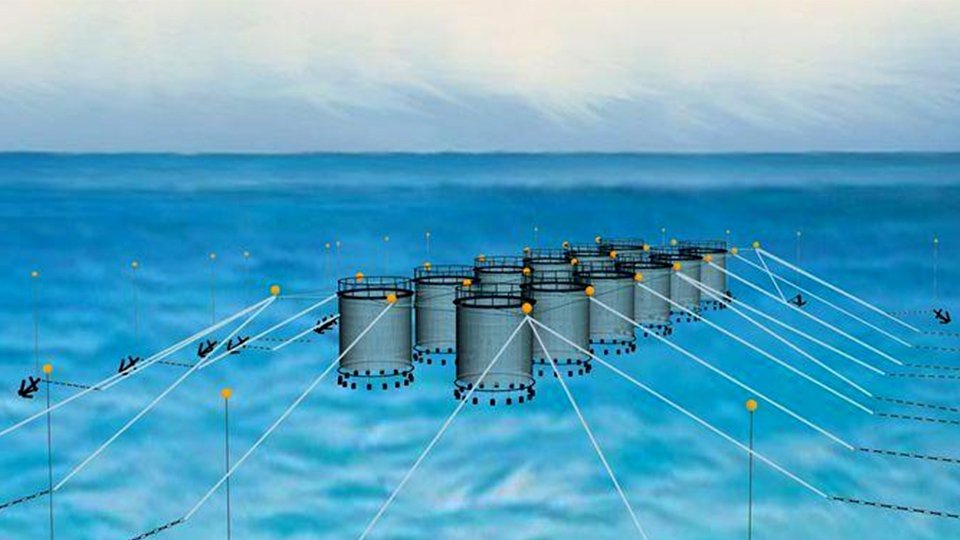The Core Role of Anchor Chains in Aquaculture
Anchor chains are the backbone and primary load-bearing component of a cage mooring system. The entire mooring system typically consists of an anchor, chain, wire rope, buoy, and link shackles. Anchor chains play an irreplaceable role, extending far beyond simply providing connections.
1. Stability and Positioning - A Core and Fundamental Role
To understand this from a deeper mechanical and biological perspective:
Resisting Environmental Loads: Cages are constantly subjected to the combined forces of wind, waves, and currents. The anchor chain, with its immense weight and strength, effectively transmits these forces to the anchor on the seafloor, creating a stable force balance system.
Precise Positioning and Management: Modern aquaculture farms typically consist of multiple cages arranged in an array. Precise positioning ensures safe distances between cages, preventing collisions. It also facilitates routine operations ( such as feeding, monitoring, and harvesting ) by bait boats and workboats along pre-defined pathways. Biological Benefits: As you mentioned, a stable environment can significantly reduce stress responses in fish. Stress can lead to weakened immunity, reduced growth efficiency, and increased susceptibility to disease. A cage environment with minimal sway is key to ensuring fish welfare and improving aquaculture profitability.
2. Providing a Catenary Effect - Key Technical Role
This is the anchor chain's most distinctive engineering contribution and its primary difference from pure steel cable mooring.
Principle: When deployed between the seabed and the water surface, the anchor chain naturally sags, forming a curve ( the catenary ) . When the cage is pushed by horizontal forces such as wind and waves, it pulls on the anchor chain.
Buffering and Recovery: The weight of the anchor chain resists this tension and absorbs energy by lifting a portion of the chain link off the seabed. This process acts like a giant spring, effectively cushioning and dissipating sudden impact forces ( such as strong waves and gusts of wind ) , smoothing out peak loads on the anchor and cage frame. Importance: This natural passive cushioning capacity significantly protects the entire system in the harshest sea conditions, preventing system collapse ( chain breakage, dragging anchor ) due to sudden overload.

3. Abrasion Resistance & Durability
Aquaculture mooring systems operate in an extremely harsh corrosive and abrasive environment.
Subsea Wear: The portion in contact with the seabed is subject to constant friction with sand and rocks.
Surface Wear: The portion connected to the cage frame and buoy is in the splash zone, experiencing the most severe corrosion and constant friction.
Advantages of Anchor Chain: Compared to steel cables, anchor chains ( especially studded anchor chains ) offer significantly superior wear resistance. Even with surface wear, their large size means they retain high residual strength. Hot-dip galvanizing provides critical corrosion protection, ensuring a long service life.
4. Fouling Suppression - A Hidden and Important Role
This is an often overlooked but crucial point. Problem: Smooth surfaces like steel cables are ideal substrates for the attachment of marine organisms, such as shellfish ( oysters and mussels ) and seaweed. Heavy biofouling can significantly increase the weight and drag of a mooring system ( up to 300 % of its original weight ) , altering its hydrodynamics and significantly increasing the load on the anchor and chain, posing serious risks.
Advantages of Anchor Chain: Anchor chain, particularly stud-link chain, has a rotating and rubbing link structure that makes it difficult for large organisms to firmly attach. While attachment still occurs, the extent is far less than with steel cables. This reduces the additional load requirements on the system design and reduces costlyunderwater cleaning and maintenance.
A Professional Explanation of the Differences in Choices Between Norway and Chile
For example, in salmon farming in Norway and Chile, Norway prefers 30-40mm stud-link anchor chains, while Chile prefers 30-40mm stud-link anchor chains. This illustrates the importance of selecting the most appropriate equipment based on local conditions and operational needs.
Norway ( Prefers Studless Link Chain ) :
Sea Conditions: Norwegian fjords and coastal areas are deep, with a rocky seabed.
Advantages: Studless anchor chains are more flexible and conform better to the rocky seabed, making them more adaptable. Their lighter weight ( compared to similar studded chains ) makes them advantageous in deepwater deployments.
Considerations: They may have slightly weaker biofouling resistance, but this issue may not be a significant issue in some Norwegian waters or may be managed through other means.
Chile ( Prefers Stud Link Chain ) :
Sea Conditions: Chilean aquaculture areas are often exposed to the high waves and strong currents of the Pacific Ocean, creating a more dynamic environment.
Advantages: Studded anchor chains, due to their crosspieces, offer greater strength ( at a given weight ) and resistance to deformation. Their biofouling resistance is particularly important in the South Pacific, where biofouling is common. Their greater stiffness also provides a slightly different catenary effect.
Summary
From a professional perspective, an anchor chain is far more than a simple iron chain; it is a precisely calculated, engineered component. Its four core functions are:
1. Providing foundation stability and precise positioning
2. Buffering dynamic loads through the catenary effect ( core advantage )
3. Providing excellent wear resistance and durability through its inherent structure
4. Effectively inhibiting the adhesion of marine organisms
Together, these functions ensure the safe, long-term, and efficient operation of aquaculture facilities in the harsh open ocean environment, making them an indispensable key technology for the success of deep-sea aquaculture. The selection of anchor chain specifications, materials, craftsmanship, and grades is a complex marine engineering discipline.
Related News:
What Are the Advantages And Risks of Farming Salmon in Chile?
Chilean Aquaculture: Issues and Challenges of Salmon Farming
Why Are Norwegian Aquaculture Semi-Submersible?
Why Are Norwegian Aquaculture Cages Round?


